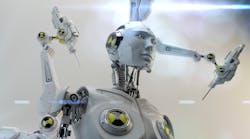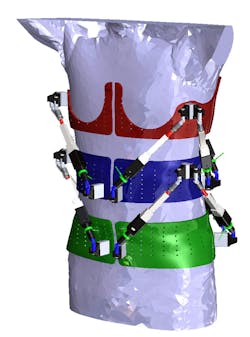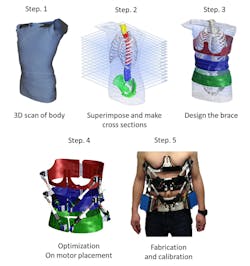New research from Columbia University looks to solve the limitations in spinal curve correction treatment. Spine deformities are characterized by an abnormal curve in the spine. The medical terms for such conditions are idiopathic scoliosis or kyphosis, commonly referred to as being “hunchbacked.” These conditions affect children in development, and the common treatment for any spinal deformity is to wear a brace that fits around the torso and hips. The brace helps to correct the abnormal curve, and it been shown to prevent the progression of the curve to avoid future surgery.
The bracing used has not changed in 50 years, however. While it stops or slows down the progression of the curve, it imposes a number of limitations and restrictions on the children. The braces are rigid, static, and analog, meaning there are no feedback sensors or technology that can monitor the patient’s progress. Also, most braces are uncomfortable and can cause skin irritation from prolonged use. The braces also do not adapt well over time, resulting in diminished effect until a new brace is made for the patient—which can be costly.
To modernize the brace, Columbia Engineering researchers have invented a new Robotic Spine Exoskeleton (RoSE). RoSE looks to solve the limitations of current brace technology and hopefully lead to new treatments for spine deformities.
The Robotic Spine Exoskeleton (RoSE) consists of two six-degrees-of-freedom, parallel-actuated modules connected in series, each with six actuated limbs. (Image Credit: Sunil Agrawal/Columbia Engineering)
Designing of the RoSE
The RoSE is a dynamic spine brace that looks at in vivo measurements of torso stiffness and characterizes the three-dimensional stiffness of the human torso. The first study was published online March 30 in IEEE Transactions of Neural Systems and Rehabilitation Engineering.
“The RoSE is the first device to measure and modulate the position or forces in all six degrees of freedom in specific regions of the torso,” says the study’s principal investigator, Sunil Agrawal, professor of mechanical engineering at Columbia Engineering and professor of rehabilitation and regenerative medicine at Columbia University Vagelos College of Physicians and Surgeons. “This study is foundational and we believe will lead to exciting advances both in characterizing and treating spine deformities.
“To our knowledge, there are no other studies on dynamic braces like ours,” Agrawal continues. Prior to developing the RoSE technology, brace studies were performed on cadavers, which did not provide a complete dynamic picture.
This video describes the design and fabrication process used in creating the RoSE. (Image Credit: Sunil Agrawal/Columbia Engineering)
The RoSE was developed by Agrawal’s Robotics and Rehabilitation (ROAR) Laboratory and consists of three rings placed on the pelvis, mid-thoracic, and upper-thoracic regions of the spine. A six-degrees-of-freedom, parallel-actuated robot is used to control the motion of two adjacent rings.
The system has 12 degrees of freedom overall that is controlled by 12 motors. With the RoSE, researchers have the ability to control the motion of the upper rings with respect to the pelvis ring or apply controlled forces on these rings during the motion. The system design can also apply corrective forces in specific directions without restricting the free motion in other directions.
The RoSE First Case Study
In the first study conducted by the team, eight male subjects without spine deformities and two male subjects with spine deformities were selected. The purpose of the pilot study was to characterize the three-dimensional stiffness of their torsos. The RoSE controlled the position/orientation of specific cross sections of the subjects’ torsos while simultaneously measuring the exerted forces/moments.
Spinal abnormal curves are three-dimensional, meaning that the stiffness characteristics are curve-specific and depend on the locations of the curve apex on the human torso. The results from the study showed that the three-dimensional stiffness of the human torso can be characterized using the RoSE, and that the spine deformities induce torso stiffness characteristics that were significantly different from the healthy subjects.
Joon-Hyuk Park, who worked on this research as a Ph.D. student and a team member at Agrawal’s ROAR laboratory says that, “In order to characterize the three-dimensional stiffness of the human torso, the RoSE applies six unidirectional displacements in each DOF of the human torso, at two different levels, while simultaneously measuring the forces and moments.”
The image above is an illustration of the design and fabrication steps used in developing the RoSE. (Image Credit: Sunil Agrawal/Columbia Engineering)
“Our results open up the possibility for designing spine braces that incorporate patient-specific torso stiffness characteristics,” adds the study’s co-principal investigator, David P. Roye, a spine surgeon and a professor of pediatric orthopedics at the Columbia University Irving Medical Center. “Our findings could also lead to new interventions using dynamic modulation of three-dimensional forces for spine deformity treatment.”
The next phase of study is to use the RoSE on female patients. In young females, idiopathic scoliosis is 10 times more common than males. “Directional difference in the stiffness of the spine may help predict which children can potentially benefit from bracing and avoid surgery,” says Agrawal.



